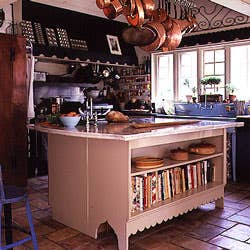
The Keeping Room
My husband, Len, and I—a realtor and an antiques dealer, respectively—share a passion for restoring old New England houses (we've tackled 12 in 30 years). But we've never had the luxury of focusing on a kitchen: In these houses, the kitchen, called a keeping room, was usually a central living area, with fireplace and hearth—not the best setting for a shiny new stovetop and stainless-steel refrigerator. So we've made do with one cramped, dark galley kitchen after another.
Then, in 1992, we dismantled a 1670 Connecticut saltbox, which abutted a highway in its original location, and reassembled it in our hometown of Bolton, Connecticut—and this time we finally had the chance to build an addition that would bring our kitchen back into this century. Expanding on the southeast corner, we created a room full of sun and space, with a garden view.
Of course, for us, the project is the fun of it, and we've taken our time filling the room (photo 1), starting with 100-year-old French terra-cotta tiles, which we put down as flooring. Slate countertops, vintage kitchen curios, and an antique cupboard followed. This time, however, we refused to be slaves to history. The piece de resistance is an aqua 1930s sink purchased at a tag sale; the Garland restaurant range was a bargain from a retiring restaurateur. And our latest indulgence—a 53" × 78" island topped with Bianca Carrara marble—makes the final transition from almost there to perfect. This house will probably be our last.
**THE DETAILS
**
Landscaping (photo 2): Antique English garden edgings, affixed to the hood of the range (they also border the vegetables outside), give the room an "old potting-shed feel," notes Betty. Made of dyed concrete, they're an ideal choice for taking the heat.
Heavy Equipment (photo 3): "We saw an advertisement for the Garland restaurant range in the paper," Len Matyia told us. "It needed a serious cleaning, but it was a steal and in perfect condition." Adds Betty, "It is absolutely indestructible."
Collector's Piece (photo 4): The pine cupboard (called a "step back") is an early 1700s antique, a gift to the Matyias from a fellow collector and family friend. Its shelves hold Betty's treenware, dishes made of wood from the same period.
Chipping Away (photo 5): Many of the pieces in the Matyias' kitchen still wear their original coat of paint, including this 19th-century American chair. "We both love old painted furniture," says Len. "The layers tell the story of how it evolved."
Color Scheme (photo 6): The discovery of this 1930s porcelain-on-steel sink—with custom skirt to hide pipes—was serendipitous, says Betty. "I went to a tag sale to check out a stove top—which was all wrong for us—then turned around and there it was!"
Keep Reading
Continue to Next Story










